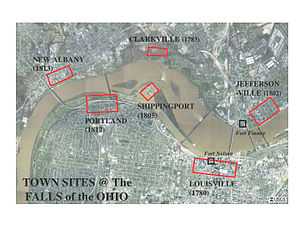Shippingport, Kentucky

Shippingport, Kentucky is an industrial site and former settlement on a peninsula near the Falls of the Ohio in what is now Louisville, Kentucky. It was incorporated without a name on October 10, 1785, then became Campbell Town after Revolutionary War soldier John Campbell, who had been granted the land for his earlier service in the French & Indian War.
In 1803 the settlement was sold to a Philadelphia-based partnership and renamed Shippingport. The new owners established a warehouse, rope walk and mill at the site, and the area began to be settled, primarily by French families fleeing the French Revolution and political chaos afterwards. From 1810 to 1820 the population jumped from 98 to over 500, and seriously challenged Louisville as Kentucky's most important port. Other early features included Elm Tree Garden, where there was horse-racing, and the Napoleon Distillery.[1] A six-story flour mill built in 1817 became a symbol of Shippingport's success.[2]

Though the town frequently flooded, it reached its peak in the 1820s with a population of 600, but the digging of the Louisville and Portland Canal in 1825 made the peninsula an island, allowing ships to bypass the Falls and, by extension, Shippingport. In 1828, Louisville incorporated as a city and included Shippingport in its boundaries. Shippingport was hard hit by the loss of its traditional business. An introductory remark in the Louisville Directory of 1844 explained public sentiment towards the canal: "The Louisville and Portland Canal, as constructed and maintained, is precisely one of those improvements for private interests, at the expense of the public good, which is obnoxious to the good of the whole community".[3]
The remnants of the settlement dwindled over the next century as the canal was gradually widened, a hydroelectric plant was built on the island, and the area was devastated by the Ohio River flood of 1937, which forced most of the remaining families to leave. The federal government acquired the remaining private property there in 1958 to widen the canal, evicting the last families, some of whom had lived there for over a century.[4]
See also
- Fort-on-Shore
- Fort Nelson (Kentucky)
- Geography of Louisville, Kentucky
- History of Louisville, Kentucky
- Portland, Louisville
References
- ↑ Burnett, Robert A. (April 1976). "Louisville's French Past". Filson Club Quarterly: 9.
- ↑ McMurtrie, Henry (1969). Sketches of Louisville and its environs. G.R. Clark Press. pp. 158–162.
- ↑ Burnett, Robert A. (April 1976). "Louisville's French Past". Filson Club Quarterly: 17.
- ↑ Burnett, Robert A. (April 1976). "Louisville's French Past". Filson Club Quarterly: 18.
External links
- Historic Maps of Louisville/Jefferson County, Kentucky from the University of Louisville Libraries. Includes street maps of Shippingport prior to razing.
- A Brief History of Shippingport Island, Kentucky
Coordinates: 38°16′30″N 85°46′43″W / 38.27510°N 85.77860°W